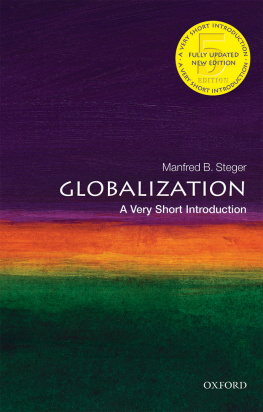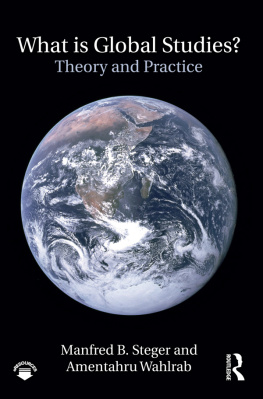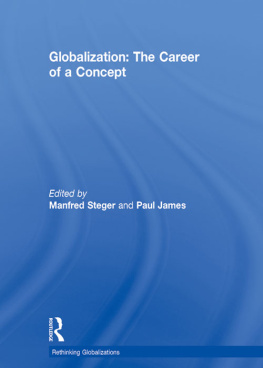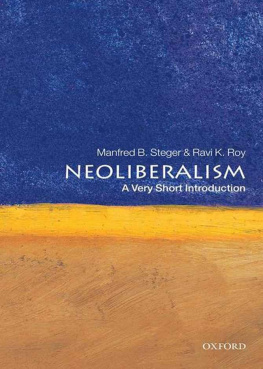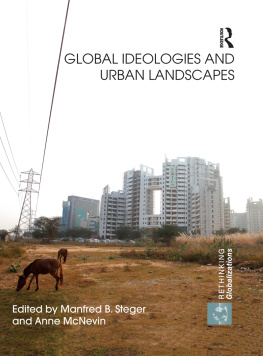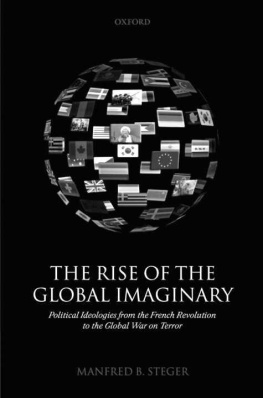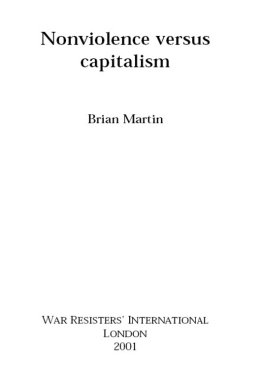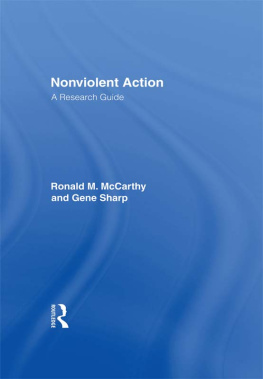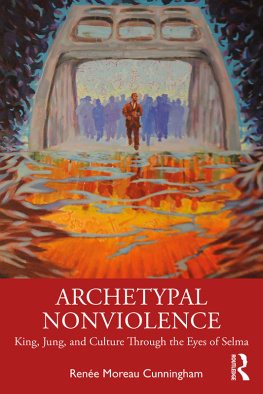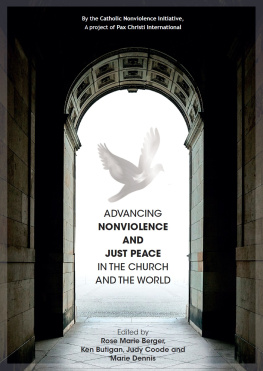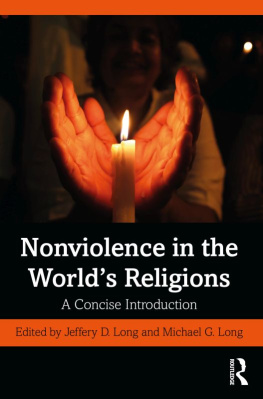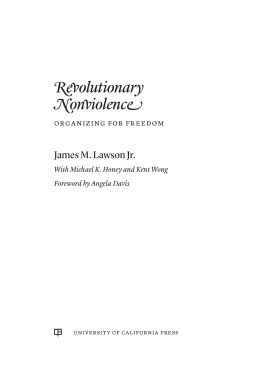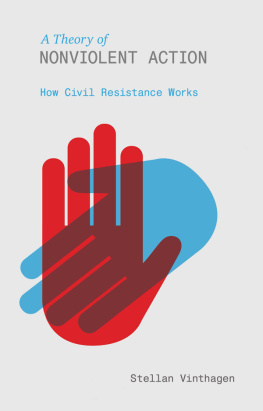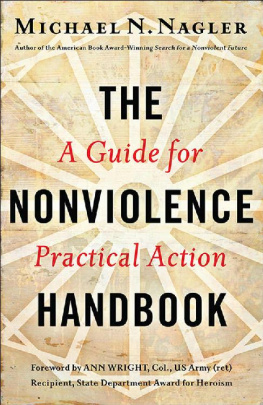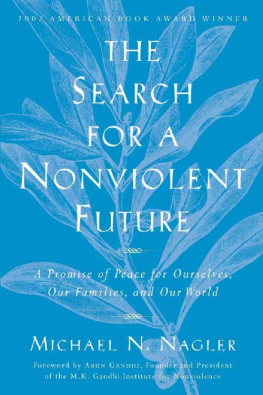Published in 2003 by
Routledge
270 Madison Avenue,
New York, NY 10016
www.routledge-ny.com
Published in Great Britain by
Routledge
2 Park Square, Milton Park, Abingdon,
Oxon OX14 4RN
www.routledge.co.uk
Copyright 2003 by Taylor & Francis Books, Inc.
Routledge is an imprint of the Taylor & Francis Group.
All rights reserved. No part of this book may be reprinted or reproduced or utilized in any form or by any electronic, mechanical, or other means, now known or hereafter invented, including photocopying and recording, or in any information storage or retrieval system, without permission in writing from the publisher.
Library of Congress Cataloging-in-Publication Data
Steger, Manfred B., 1961
Judging nonviolence : the dispute between realists and idealists / Manfred B. Steger.
p. cm.
Includes bibliographical references and index.
ISBN 0-415-93396-X (alk. paper) ISBN 0-415-93397-8 (pbk. : alk. paper)
1. Nonviolence. 2. NonviolencePhilosophy. I. Title.
HM1281.S746 2003
303.6'1dc21
2003009381
PREFACE AND ACKNOWLEDGMENTS
Is it possible to engage in power politics and yet remain nonviolent in theory and practice? Can political ends be achieved by nonviolent means? Is Martin Luther King, Jr.s dream of a nonviolent society applicable to the real world? Can a violent aggressor be repelled nonviolently?
These questions have been at the center of undergraduate classes on the politics of nonviolence that I have been teaching at two American universities for almost a decade. Although some of my students remained skeptical about the possibility of fully reconciling nonviolent principles and political power, the vast majority of them nonetheless conceded at the end of the semester that nonviolence constitutes a far more potent political method than they had originally thought. Nearly unanimous in their opinion that nonviolent forms of political struggle are not being given fair consideration in a society in which violence is habitually sanitized and normalized, my students urged me to write an accessible college text based on our highly successful class format of putting nonviolence on trial. After several years of being too busy to write such a text, I have made doing so a priority.
In addition to attesting to my students persistence, this book is also a testimony to my own desire to challenge the dominant ideology of violence. Expressed in cold numbers, the social and environmental impacts of violence are truly frightening. Researchers have calculated that war-related killings in the twentieth century exceeded 105 million people, including 62 million civilian victims. Still, there is little indication that we have learned the bloody lessons of the past. Let us consider contemporary American society. Today, U.S. citizens own a total of 70 million rifles, 65 million handguns, 49 million shotguns, and 8 million other long guns. More than 15,000 Americans are murdered each year. Every day in the United States four women are murdered by a male partner. Each year, 6 million women are beaten in their homes. Each year, as many as 6.9 million American children may by physically abused, depending on the definition used. Total homicides in the United States since World War II are estimated to be at least 750,000, thus exceeding the 650,000 total battle deaths in all of Americas major wars. The prison population in this country has exploded to 1.8 million, including almost 4,000 convicts who await execution.
This goes to show how the pervasiveness of our culture of violence makes reliance on force a normal occurrence. Add to this culture of violence the widespread and easy availability of arms and you get an explosive recipe. To be sure, the obsession with violence is not an exclusively American phenomenon. Yet many studies have shown that Americans are far more accepting of violence than citizens of other nations. Rates of violence are much higher in the United States than in any other industrialized nation. For example, there is a dramatic contrast between levels of violence in Canada and the United States, two countries that share a long common border and many similar values and cultural traits. For more than half a century, levels of violence as measured by homicide rates have consistently been four times higher in the United States than in Canada.
From the day they are old enough to sit in front of a television set, American youngsters are fed a steady stream of media images and sound bites that often depict violence as heroic and inevitable. Video games and popular music frequently glamorize violence. Jeff Bleich, executive director of the National Campaign Against Youth Violence, has long argued that violence constitutes a central pillar of the American belief system. We encourage boysand increasingly girlsto believe that in order to become honorable persons, they must demonstrate that they are willing to use violence. Our enthusiasm for guns, our glorification of war and the military, our choice of superheroes, our appetite for violent sports games, and our use of belligerent language reflect the myriad ways in which we put violence at the center of our collective identity. And yet, violence is a financial drain on the resources of a nation. Conservative calculations show that the U.S. nuclear weapons program alone cost taxpayers almost $6 trillion during the last five decades.
One reason why nonviolence is so easily dismissed in public discourse seems to be obvious: a serious consideration of nonviolent strategies might create an alternative vantage point from which the alleged normality of violence could be challenged. This widespread reluctance to afford the subject of nonviolence a more prominent place in our public discourse and educational programs points to the remarkable power of social forces with vested economic and political interests in protecting the business of violencebe it violence-glorifying entertainment, war, or the global arms trade. Often hiding their commercial interests behind the language of security and necessity, these forces habitually downplay the feasibility of nonviolent politics. Instead, they present violence as a universal urge or set of unalterable biological behaviors sewn into the very fabric of human nature that get played out on the allegedly anarchic stage of international politics. The nonviolence movements of the twentieth century are dismissed as either grand moral experiments that ultimately failed or rare exceptions that merely confirm the (violent) rule.
Drawing on a variety of political, cultural, and philosophical insights, this textbook provides students and general readers with vital information about nonviolence in theory and practice while encouraging them to evaluate critically the arguments for and against nonviolence. Assuming the role of jurors in a simulated trial in which nonviolence must prove its effectiveness, readers will be asked to listen attentively and impartially to the first-person testimonies given by expert witnesses for the prosecution (the realists) and for the defense (the idealists). Jurors will weigh direct and circumstantial evidence; rethink their preconceived opinions; follow up on possible questions for cross-examination; explore further readings; consider exhibits such as illustrations, films, and web sites; and, finally, find nonviolence guilty or not guilty as charged by the realists.


